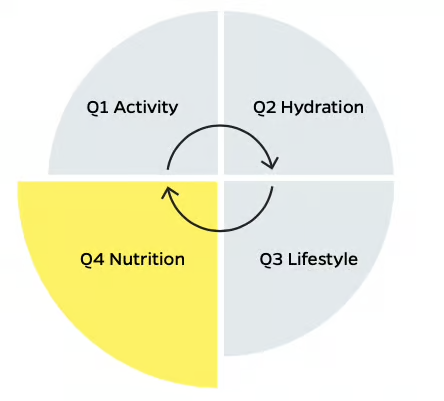
I hope you enjoy reading this blog post.
James Breese, Cricket Matters FounderIf you need my help with cricket coaching, strength and conditioning, injury rehab, or nutrition, click here.
This beginner-friendly guide introduces the essential aspects of nutrition for cricketers.
Before we master advanced nutrition for cricketers, we need to create a solid foundation so that we set the stage for your nutrition plan to work.
From our experience, most cricketers, even professionals don’t understand the basics of nutrition.
After working with thousands of athletes all over the world, in this blog, we share our personal insights and feedback on what a successful nutrition plan for cricketers looks like, and why it should be built on rock solid foundations and habits.
Here’s what we’ve learned over the years, and we hope it helps your cricketing performance on the field.
Table of Contents
Cricket is a physically demanding sport that requires a combination of strength, agility, and endurance. To perform at their best, cricketers must fuel their bodies with the right nutrients.
A well-balanced diet can improve energy levels, speed up recovery, and enhance overall athletic performance.
But with so much information available online, it can be challenging to know where cricketers should start to learn about nutrition.
That’s why we’ve created this beginner’s guide to nutrition for cricketers.
Whether you’re a seasoned player or just starting, this guide will provide you with the essential information you need to get started, and take your game to the next level.
However, before you can learn about advanced nutrition strategies, you need to learn the fundamentals of nutrition.
This is the Cricket Matters approach to nutrition and how we apply this system to our cricket athletes.
Introduction
2020 is the year I finally gave up trying to prove that all you need is a magic training plan to help you lose body fat. I’ve tried every way possible to prove otherwise and failed.
This is one of the hardest concepts I’ve had to grasp during my personal training career.
Exercise alone will help you to a point, if you are above 30 percent body fat (40 percent for women), but it will only get you so far. This is why nutrition becomes so important.
Exercise Alone Does Not Build Cricketing Athletes

Is exercise important? Absolutely! However, if you don’t address your nutritional needs, you will always be swimming against the tide or, even worse, going around and around in circles not getting anywhere.
Studies conducted by nutrition guru Dr. John Berardi have proven if you test the effects of exercise alone, without diet, not much will happen over 12 weeks.
One of Dr. Berardi’s studies looked at nearly 100 participants who either stayed sedentary or began exercising. The exercisers were given a program to follow that added about six hours of activity per week for a total of 12 weeks.
The non-exercisers did nothing for the 12 weeks except show up for measurement sessions. These participants were not exercisers before the study began.
They were Average Joes and Janes between 35 percent and 45 percent body fat, as indicated by DEXA body scans. So, what happened at the end of 12 weeks?
Not much!
You could argue that maybe it was a poor training program. For some studies, I’d agree with you. However, if you know of Dr. Berardi, you know he is a highly skilled strength coach who has worked at the highest levels.
He programmed three weight training sessions and two group exercise sessions per week for the active group. While the sedentary group carried on as normal.
The data showed that three plus hours of training per week with a weightlifting coach and two plus hours of training per week with a bodyweight circuit instructor didn’t really affect body fat percentages.
The active participants didn’t do much better than their couch-sitting counterparts.
Without dietary control, 12 weeks of training produced a disappointing one percent average loss of body fat.
Active participants lost only one pound of fat and gained two pounds of lean muscle mass versus the placebo group’s unchanged numbers.
Let’s put this in real terms. It’s a scenario I’ve witnessed time and time again with my own clients. Imagine you’re overweight and you’ve decided to invest in a personal trainer to get in shape for perhaps the first time in your life.
You buy a 12 week training package, one that contains five sessions per week for a total of £5,000 (the going rate for most trainers these days).
You don’t expect a miracle but you do expect to see some change at the end of 12 weeks.
You attend all your training sessions and do everything that is asked of you.
At the end of the 12 weeks, you see the following:
- Your body weight increased by a pound.
- Your fat weight decreased by a pound.
- Your lean weight increased by two pounds.
Exercise is critically important to help you lose body fat, look better, feel better, and perform better every single day.
However, it doesn’t work alone. You need a solid exercise plan PLUS a sound nutritional program.
When you combine both, wonders can happen. Our cricketing athletes lose on average two to three pounds per week when everything is on point, sometimes more.
But where should you start when it comes to nutrition for cricketers?
There are many schools of thought but here’s how we approach nutrition for cricketers as a beginner.
Nutrition for Cricketers: The Cricket Matters Approach

Human bodies come in all shapes and sizes. I don’t believe in body shaming, fat shaming, or anything else that affects body positivity in any way, shape, or form.
When anyone at Cricket Matters talks about fat loss, we talk about it in terms of health, longevity, and athletic performance.
Aesthetics is not our focus. It’s just a nice side effect of quality training and nutrition principles.
Our focus is athleticism and performance and how cricketers can perform at the highest levels whilst living healthily.
To lead a healthy and athletic lifestyle though, we often have to have difficult conversations with our cricketing athletes about weight and fat loss.
Mainstream media mostly discusses fatness both in terms of aesthetics and medical conditions that can kill or disable us.
Since we’re all going to die anyway, medical scare tactics simply don’t work.
Valid points, yes, but not necessarily compelling reasons to change.
Meanwhile, the fitness industry makes it all about aesthetics and getting there in the least amount of time possible. Detoxes and 21 day challenges are all the rage these days.
While this motivates people for short periods, get thin quick schemes are not sustainable and are not proven to enable long-term maintenance of weight or fat loss.
Most nutritionists and diet gurus talk about what to eat, how to eat, and when to eat. “Abs are only made in the kitchen” is something we often hear.
As a result, people put a huge emphasis on the food component of weight loss and nutrition first.
It is without a doubt extremely important, and please don’t think we’re saying diet is not important for fat loss or to performance, health and longevity.
But, if there are so many good reasons for healthy eating, why is it so difficult to actually do so?
Diet and nutrition programmes only work if and when you follow them. If you revert to your old habits, you’ll revert to your old body weight again. And nothing is easier than falling back into old habits.
If you haven’t exercised in a long time, trying to create a new exercise habit is hard. In fact, it can be demoralizing and downright impossible in certain situations.
Trying to implement exercise and nutrition programming at the same time can overwhelm even the most willing individuals. Is it any wonder that so many cricketers struggle with their weight?
At Cricket Matters, we love our systems. Systems provide a solid framework to help reach any goal.
In our mind, the key to long-term nutritional and weight loss success was to create a system that allowed cricketers to develop new habits for the long haul, and keep stacking new habits onto the old habits without falling off the wagon.
We found that when we put food first, athlete results were not as significant as they were for athletes with whom we did NOT prioritize food.
Fat loss athletes who prioritized food often became less compliant with their workouts.
They averaged a measly 57 percent compliance rate overall compared to our performance clients who were all above 92 percent.
Interestingly, we found that the average time a weight loss athlete stayed with us was three to six months, as opposed to 18 to 24 months for a performance client.
We were failing our fat loss athletes.
We needed to address this, fast. So we looked at our in-house data to find a solution, and what we found was remarkable.
What Our Data Told Us

Research shows that several lifestyle and environmental factors influence metabolism and weight control. There is simply no single reason why people gain weight or fat.
We had to find common ground between every single one of our athletes, using data that we track regularly and already had.
Although workouts and assessments varied from athlete to athlete, the common factors we tracked were steps, water consumption, and sleep.
When we averaged out the data across the board, we couldn’t believe what we saw:
Weight Loss Athletes:
- Average number of steps per day = 3,109
- Average number of glasses of water = 3
- Average number of hours of sleep per night = 4-5 hours
- Average workout compliance rate = 57%
Performance Athletes:
- Average number of steps per day = 9.378
- Average number of glasses of water = 7
- Average number of hours of sleep per night = 7.2 hours
- Average workout compliance rate = 92%
We were dumbfounded. Our performance athletes were walking three times more per day, drinking double the amount of water per day, and sleeping two to three hours more a night.
We didn’t need to give our weight loss athletes more workouts or an in-depth nutritional plan. We needed to help them master the fundamental basics of health and longevity: Walking, water, and sleep.
If you can’t master these basic habits, how can you possibly master nutrition? Our performance clients seemed to have these fundamental habits nailed down. They were doing them as part of their normal daily routine. Our weight loss clients had not yet mastered these habits.
With this information in hand, we put our thinking caps on and went to work developing the Cricket Matters Nutritional Process.

Cricketers who master Q1, Q2, and Q3 (walk, water, sleep) can quickly advance to Q4—nutrition. However, we never proceed to the next quadrant until we have mastered the previous one.
And when we say master, keep in mind it takes at least 66 days to form a habit, not two weeks or 21 days or whatever expression you remember.
We discussed at length the importance of each quadrant and agreed that the easiest habit to change was the walking. It’s a skill we all do every day, and there’s no avoiding it.
Our theory was if we walked more each day, we’d naturally want to drink more. And if we expended more energy walking and hydrating, it would also improve our quality of sleep. Simple. Right?
Nutrition for Cricketers: What We Changed

Once we had the process ironed out, we sought to achieve two goals with all of our athletes:
- To hit a perfect 100 percent compliance rate with their workouts (minimum two per week) and
- To take their daily step count to 10,000 steps. And we gave ourselves 60 days to get there.
We decided to start with ten weight loss athletes, ten very important people that would test the feasibility of our goals. First, we asked each of our clients to ensure they had some form of step tracking device.
Most already had one or opted to purchase a Fitbit or Apple Watch. We asked for their total number of steps in the previous 14 days and calculated their average daily step count.
We set a daily task that they were held accountable to through our tracking software. They had to hit their personalized average step count per day plus 500 steps.
For example, if the average was 3,500, we’d ask them to hit 4,000 per day.
Each day, the athletes had to upload a picture of their step count to their coach to confirm they had done it. We asked them to continue as normal with their workouts but emphasized the most important factor each day was to hit their step target.
After 60 days, we asked each of our clients to track their water consumption and sleep habits for a week.
Over the first 14 days, each of these ten athletes hit their daily step target. In fact, some exceeded their average step count by as much as 2,000 steps a day. After 14 days of complete compliance, we increased the step target.
For some, we increased 1,000 steps but, in one case, we added an extra 3,000 steps to the original starting point. We continued in exactly the same way as before, asking them to complete their daily steps and their weekly workouts.
We mostly deflected questions about nutrition, water, or sleep, and brought it back to the task at hand. Just keep walking.
After 60 days, average workout compliance hit 81 percent and client daily step count rose to over 7,000. A couple even managed to hit 100 percent compliance with their workouts and complete over 10,000 steps per day.
Here’s a reminder of what the data was initially:
Weight Loss Athletes BEFORE the New Initiative:
- Average number of steps per day = 3,109
- Average number of glasses of water = 3
- Average number of hours of sleep per night = 4-5 hours
- Average workout compliance rate = 57%
And here are the results after 60 days of increased walking:
Weight Loss Clients AFTER the New Initiative:
- Average number of steps per day = 7.362
- Average number of glasses of water = 5
- Average number of hours of sleep per night = 5-6 hours
- Average workout compliance rate = 81%
Walking increased by 100 percent, water consumption increased by 60 percent, and sleep hours increased by 25 percent. The workouts stayed the same but we stopped talking about diet and nutrition and everything else.
We simply held each weight loss client accountable for walking a personalized number of steps each day. That was it.
Oh, and a welcome side effect, the average weight loss during this period was 11 pounds.
The Weight Loss Domino Effect

The domino effect is the cumulative effect produced when one event sets off a chain of similar events. Our thought process: What if walking daily initiates the weight loss domino effect?
Author James Clear believes there are two reasons why the domino effect occurs:
- Many of the habits and routines that make up our daily lives are related to one another.
- The domino effect capitalizes on two core principles of human behavior − commitment and consistency.
A 2012 study from Northwestern University found that when people decreased their amount of sedentary leisure time each day, they also reduced their daily fat intake.
The participants were never specifically told to eat less fat, but their nutrition habits improved as a natural side effect because they spent less time on the couch watching television and mindlessly eating.
One habit led to another. One domino knocked down the next.
Our weight loss athletes were beginning to see the domino effect in action. Workout consistency was up, water consumption was up, and average sleeping time was up.
We had only asked them to walk a few more steps than they were used to doing each day, and we held them accountable to it.
Our ultimate goal was to get everyone walking 10,000 steps a day as a habit they wouldn’t have to think about ever again.
The Power of 10,000 Steps
A number of our athletes had already mastered the 10,000 steps per day rule and had successfully maintained their daily average.
Maintenance over a period of 60 days is key. Remember, 66 days and it becomes a habit. That’s science.
The priority for these cricketers was now to move to the hydration quadrant and monitor their water intake. Many were already drinking more water and successfully hitting the target of seven to eight glasses a day.
We monitored this for a period of two weeks. If they had maintained the habit of seven to eight glasses of water a day WHILE walking 10,000 steps, we progressed to the sleep quadrant.
For those who didn’t quite reach 10,000 steps a day, we continued to work with them on finding ways to succeed. We looked at daily routines and other habits to help them overcome this issue.
Walking and working out were still the priorities. They were still Q1 clients, we just had to learn more about their daily routines and habits to help them get over this hurdle.
What small changes could they make over time to increase their steps, e.g., park further away in parking lots, take the stairs more often, etc.
They were like Roger Bannister before he first broke his four minute mile. Ten thousand steps was their personal four minute mile barrier. We felt that once we helped them overcome this barrier, we’d see significant breakthroughs in other areas much more quickly.
As our athletes worked through the four quadrants, weight loss continued to increase and athletic performance continued to improve. Not only were they losing weight faster, but they were getting stronger and fitter too. And their compliance rates rose above 80 percent.
Nutrition for Cricketers: Why Nutrition Comes Last
Addressing nutritional needs alongside a structured exercise routine is by far the fastest way to achieve a fat loss or performance related goal. As you know now, nutrition for cricketers is far more complex than people make it out to be.
To get to this stage, we have to address your basic lifestyle habits first and make sure they are nailed down. If they aren’t, you are setting yourself up for failure.
Nutrition for cricketers is hard. It can be mentally and physically exhausting. You need time, patience, and the will of a Jedi to stick to it. But when you get it right, you will be rewarded.
We believe that there is no one diet that’s best for cricketers. That is unique to each athlete. What we do next though, goes beyond what type of diet you want to follow. It starts with science and the basic premise of calories in and calories out.
Nutrition for cricketers is simple, in theory. Every diet will work long as it creates a calorie deficit. Our goal as cricketers shouldn’t just be weight loss. We need to lose fat while retaining or increasing our lean mass.
What will determine overall weight loss is energy balance. To lose weight, the amount of energy you expend every day will need to exceed the amount of energy – the calories – you consume.
While some people in today’s world have convinced themselves that calories don’t matter or that you can consume as many calories from good foods as you want and still lose weight, this is a complete and utter fallacy, and numerous research studies have shown it as such.
The first stage in your nutrition for cricketers and dieting for cricketers journey begins with determining your maintenance calories.
Keeping in mind that to lose fat, you need to create a caloric deficit. Or to increase muscle mass, you need to create a caloric surplus.
Most people have no idea what their actual maintenance level of calories is. The only way to determine this comes with a lot of trial and error and using complex math to get you here.
Even then, you need to spend several weeks at your maintenance calories to see if you do maintain your weight. This requires patience. And lots of it.
Final Thoughts: Nutrition for Cricketers
Nutrition is hard. Nutrition for cricketers is hard. Fat loss for cricketers is extremely hard. It’s the holy grail of athletic performance and there is no quick solution that will help everyone. Hopefully, you now understand that exercise alone will not get you the results you so desperately want.
It has to be a combination of both diet and exercise. The diet aspect of the equation is not as simple and as straight forward as it seems – there are a lot of moving parts, both physically and mentally.
Long-term fat loss and nutrition success requires basic healthy habits in place to support your diet and performance goals. Without them, you are just setting yourself up for failure.
Fat loss is a marathon, not a sprint. Instead of thinking about how much weight you can lose in 30 days, try one year. It will keep you on the straight and narrow.
If you want that ultimate body – that strong, muscular, functional, lean, healthy physique – then you need to be training frequently, training multiple qualities, and doing so consistently.
There’s no substitute for hard work. And above all, don’t neglect your diet. You cannot out train a poor diet, and your body needs the best fuel you can provide.
Further Reading
FAQs
What Nutritional Health Habits are Important for Cricketers?
For cricketers, fundamental health habits include maintaining regular physical activity, ensuring adequate hydration, and getting sufficient sleep. Regular walking can boost stamina, while adequate water intake is crucial for hydration during training and matches. Sufficient sleep aids in recovery and enhances overall performance.
How Does Proper Nutrition Impact a Cricketer’s Performance?
Proper nutrition significantly impacts a cricketer’s performance. A balanced diet provides the necessary energy for playing and aids in faster recovery post-match. It also contributes to better concentration and focus, essential for the mental aspects of cricket.
What Type of Diet is Recommended for Beginner Cricketers?
Beginner cricketers are advised to follow a balanced diet rich in carbohydrates, proteins, and healthy fats. Carbohydrates provide energy, proteins aid in muscle repair and growth, and fats offer essential fatty acids. Including a variety of fruits and vegetables ensures adequate vitamins and minerals.
How Important is Hydration for Cricketers?
Hydration is extremely important for cricketers. It helps maintain concentration, prevents fatigue, and aids in temperature regulation during play. Cricketers should drink water regularly throughout the day, especially during training and matches, to stay adequately hydrated.
What is the Best Diet for a Cricketer?
The best diet for a cricketer should be balanced and tailored to their energy needs. It typically includes a high intake of carbohydrates for energy, lean proteins for muscle repair and growth, and healthy fats for overall health. Ample fruits and vegetables are essential for vitamins and minerals. Hydration is crucial, so drinking plenty of water is recommended. It’s important for cricketers to adjust their diet based on their training intensity and match schedules.



